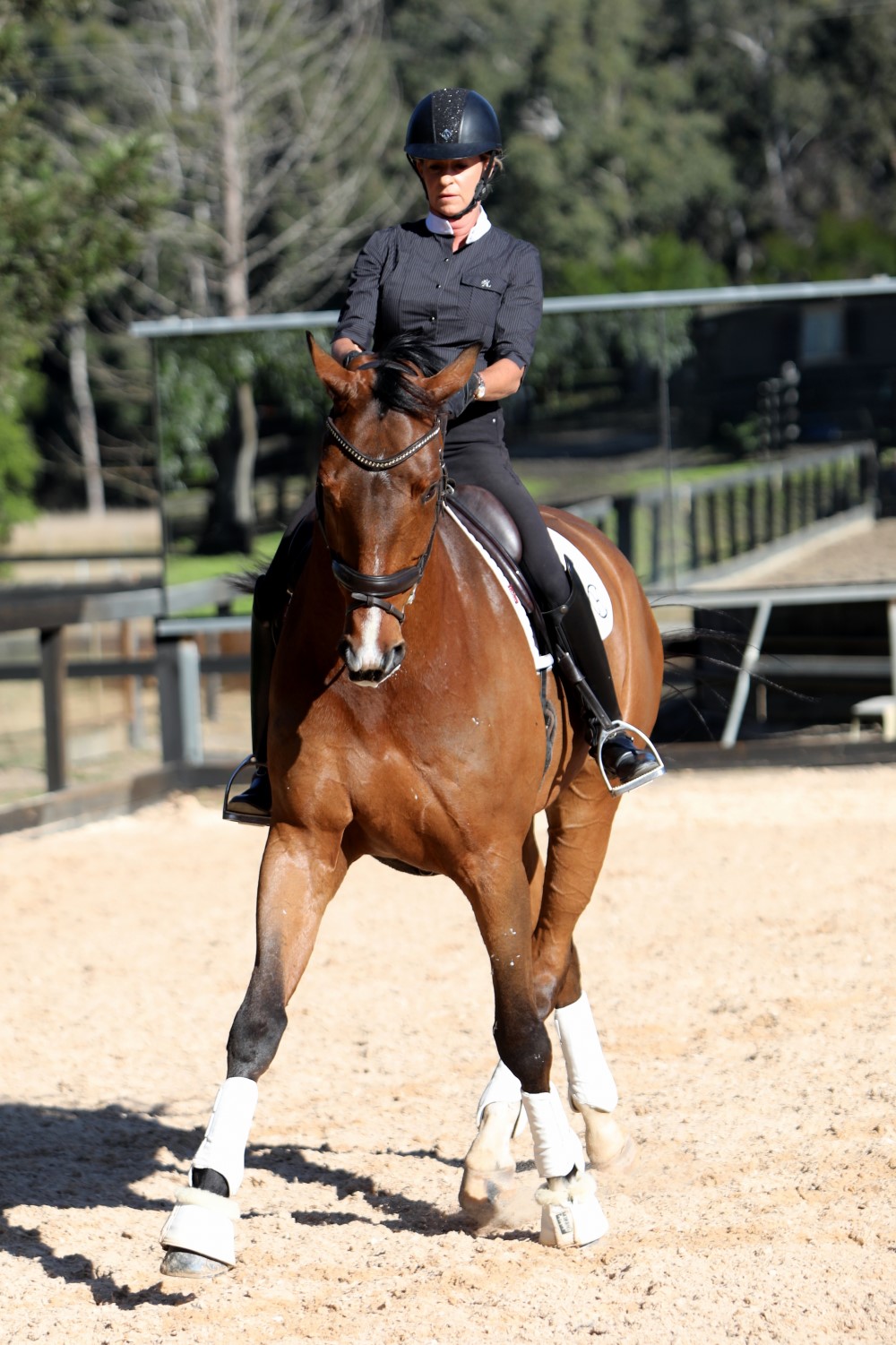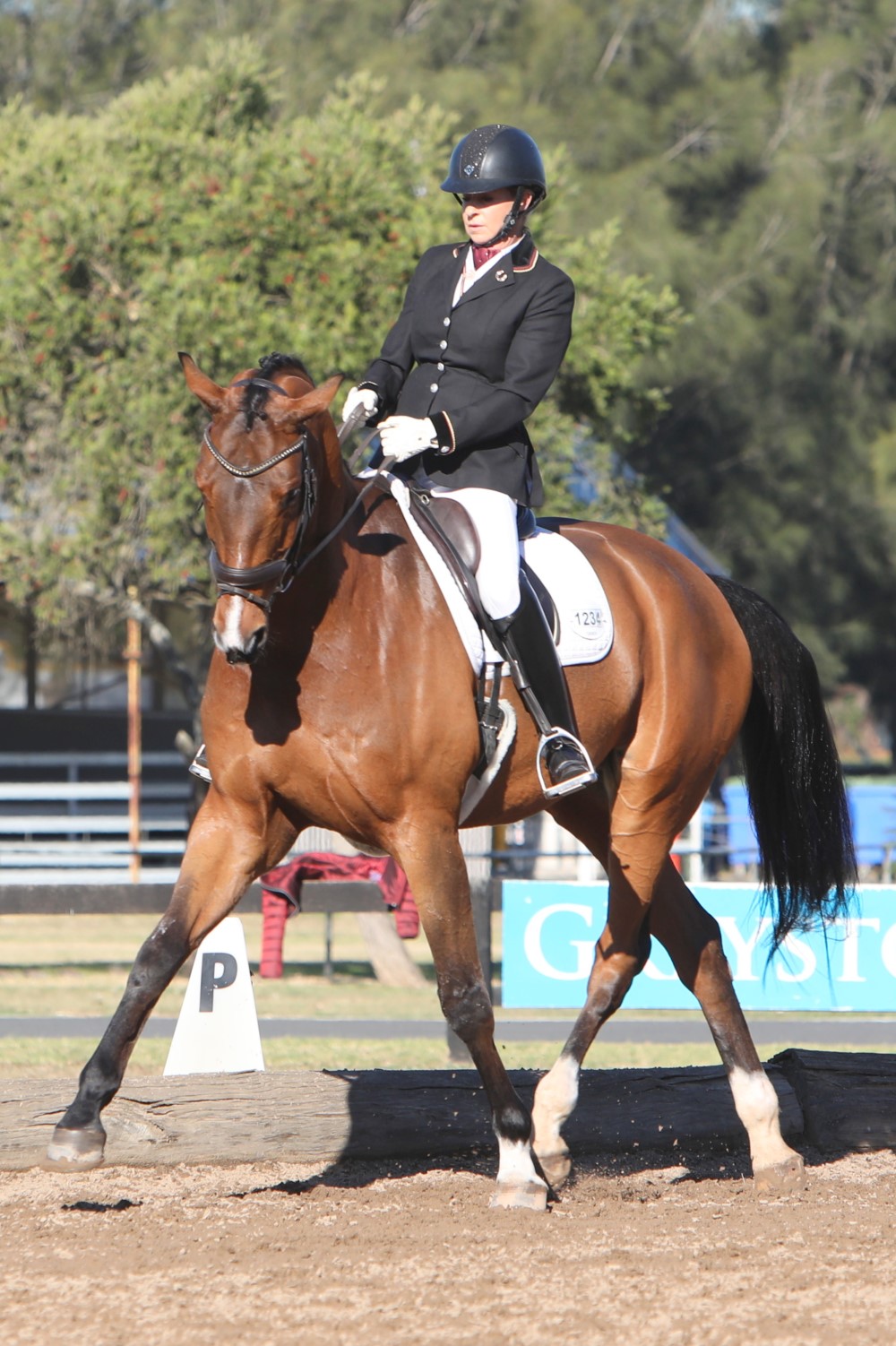Whatever the discipline we are training our horse in, our goal should be a happy and relaxed athlete. A supple horse will be relaxed in mind and body. This is the real importance of training specifically for suppleness.
The Training Scale is a guide to training our horses. It is like a hierarchy of what is important – rhythm, suppleness, contact, straightness, impulsion and collection. Correct rhythm refers to the trueness of the paces, the regularity and the tempo. An unbalanced horse will lose the regularity and correctness of the rhythm. I have written about rhythm before. Rhythm is like the North Star of training: if you lose the rhythm your horse is letting you know that he is struggling.
Suppleness refers to the horse’s ability to bend and is one of the key elements of softness. A bent horse is a soft horse. Think about it. A rearing or bolting horse will not be bent. If your horse is pulling, he will generally be pulling on both reins. When he is using his strength against you, he will most often be straight – but not necessarily correctly straight as in the higher-level Training Scale. Of course, a soft horse can be straight, but bending and suppleness is a pathway to softness.

“Bending and suppleness
is a pathway to softness.”
The modern Training Scale has been developed from the German military manual. In the German Training Scale, the second quality is ‘Losgelassenheit’, sometimes translated as looseness. In English, suppleness is perhaps easier to understand than looseness. Suppleness is often grouped with elasticity and relaxation. A relaxed horse will have a more supple back and is more likely to be able to bend his joints and allow the hind leg to reach under his body. He will be more easily able to vary the length of the steps while keeping the rhythm.
Suppleness refers to both lateral (side to side) bending and longitudinal (front to back) flexion, including reaching forwards and down to the bit with an open gullet. Muscles work most effectively when they are stretched, so suppling a horse includes stretching longitudinally and laterally. A supple horse will bend easily in the corners and on circles. Although the ribcage of the horse will not bend very much, the horse gives the impression of a consistent bending from nose to tail partly by allowing the ribcage to rotate between the shoulder blades. This is possible for a horse but not for a human as the horse does not have a collarbone acting as a strut to stabilise the ribcage to the shoulder. The horse only has a ring of muscles connecting the ribcage to the shoulder.
Some horses are born more supple. A warmblood is likely to be more supple than an off the track Thoroughbred. Correct systematic training will help develop suppleness. I believe a supple horse is less likely to become injured.

“Suppleness precedes impulsion…”
Suppleness precedes impulsion as a supple horse will be more able to increase the steps by making the hind legs come forwards under him, rather than reaching with the front legs. This is important for jumpers as well as dressage horses. The bigger fences and complex lines require a supple horse who can lengthen the steps from the hind legs and make more energy without just using speed to do it.
Of course, you can’t just pull a horse’s mouth to the side to make him supple. It has to be done step by step over time. Every corner is an opportunity to bend him around your inside leg. As he bends, his inside hind leg steps under his body and carries weight.
There are many exercises to help develop suppleness. A corner is one quarter of a circle, and it gives you the opportunity to ride six steps of bending and stepping under with the inside hind leg before the release of this pressure as he goes straight forwards again. You can ride a small square: corner with bend, allow him straight, another corner. Serpentines and figure eights with careful changes of the bend are also good exercises. Stretch him in front of the wither as you do it.
A leg-yield is an easy way to bend around the inside leg. Start with a small circle and just allow him to move away from your inside leg into the outside rein as you allow the circle to get bigger. This is a spiral we call the ‘snail exercise’. Then you can leg-yield from the wall to the centre and stay on the same rein when you turn at the end. Trot on the right rein, leg-yield left to the centreline, straight up the centreline and then track right and repeat. The repetition helps you to build the suppleness on that rein before you change rein.

A circle is a wonderful tool to build suppleness. On a circle, you don’t have to stop an exercise just because you run out of room. You can keep asking until he gives you the right answer, and then ride forwards, or allow the circle to be bigger. Start with a comfortable circle, maybe 15-18 metres, depending on his level of experience and balance. The more supple the horse, the smaller the circle can be.
You can ride the leg-yield on the circle, just ask him to bend to the outside of the circle counter-bending him. Your outside leg helps push the hindquarter in to the circle, carrying weight. The shoulders are doing a slightly larger circle than the hindquarter. The bend to the outside is easier for the inexperienced horse. You can ride the circle in shoulder-in, with the shoulders on a smaller circle than the quarters. Then ride the circle in travers. The quarters are in on the smaller circle, the bend around your inside leg and the outside rein is holding the shoulder to the outside. Slowly over time he will find these exercises easier, and you can make the circle smaller.
Quietly and slowly, step by step, ask him to go from one to the other, leg-yield, shoulder-in, travers. Eventually he will be able to even do the renvers on the circle; the shoulder is on the smaller circle line, bent around the leg on the outside of the circle. Renvers is rarely asked for in competition, but is an excellent training tool. Always try to keep the neck long, reaching to the rein with a feeling that the withers are up. Anytime you are doing something new, shape the behaviour by asking for a small amount and rewarding an attempt. Don’t stay in an exercise too long as you don’t want the unfamiliar movement to build up lactic acid in his muscles and hurt.

Just as riding a circle line and changing the lateral exercise builds suppleness, you can do similar things on a straighter diagonal line. Half-pass to leg-yield, along a long diagonal line, flipping the bend but keeping the line and rhythm. You can also ride half-pass to leg-yield, keeping the bend the same but doing a zigzag line.
A horse that is naturally a flexible athlete may lack suppleness as he is not really “through”, meaning that he is not really allowing the effect of the rein to go through to the hind leg; he is holding himself and blocking. He might carry his head tilted to one side. To help him correct this, you can ask for a greater degree of bending on a small circle with an opening rein. Ride a circle about 12 metres in diameter and take your inside hand to the inside. Your outside hand must allow the outside of his neck to lengthen. Push him like a leg-yield so the shoulders are keeping a smaller circle than the hindquarters. Just keep asking in a friendly way, inside leg to outside rein, until you feel him let go and become softer. You may feel his back come up a bit and he won’t be balancing on the inside rein. When he lets go, you can let go. See if he will keep going on the circle easily without pressure, reaching into the outside rein.
No doubt sometimes he will get strong and pull against you. If he is pulling, he is probably not moving with looseness and suppleness. You might want to keep the focus on what you want – suppleness – and not what you don’t want – pulling. It is very easy to fall into the trap of pulling when he pulls, to try to make him give. But it can be helpful just to go back to these suppling exercises to loosen him up and then go back to whatever it was that started him pulling. For example, if you’re working on lengthening the canter and he gets strong, just turn him into the small circle and re-establish suppleness before you go on.
Perhaps you are training the flying changes and he is throwing himself through the change, getting strong. Try to place the change before a corner or heading to the wall and put a circle in after the change. If you need to go back to the leg-yield, shoulder-in and travers on the circle to reestablish suppleness, that is fine. Don’t repeat the change until you have the suppleness and throughness. Take the same approach with a jumping horse that gets strong on landing. Jump, land and return to the circle exercise to regain suppleness. Then jump again.
Remember, the true art is in the training to produce a soft, supple and happy athlete.
Have fun. EQ
YOU MIGHT ALSO LIKE TO READ BY KERRY MACK:
Perfecting The Pirouettes – Equestrian Life, August 2023
Get In The Zone & Go With The Flow – Equestrian Life, July 2023
How to Resolve Common Problems – Equestrian Life, June 2023
A Smarter Way to Compete – Equestrian Life, May 2023
What Motivates Me – Equestrian Life, March 2023
More Than a Walk in the Park – Equestrian Life, February 2023
Scott Keach Makes His Own Luck – Equestrian Life, December 2022
No Room for Bullying in Our Sport – Equestrian Life, November 2022
Avoid the Mud (Play Indoors) – Equestrian Life, October 2022
Why We Love Our Sport – Equestrian Life, September 2022
Getting on the Bit – Equestrian Life, July 2022
Positive Training Really Clicks with Horses – Equestrian Life, June 2022
Learn From Your Mistakes – Equestrian Life, March 2022 issue
Young Horse Classes: A Fun Launching Pad – Equestrian Life, February 2022
Making Sense of all the Bits & Pieces – Equestrian Life, January 2022
The Secret to ‘Soft Hands‘ – Equestrian Life, December 2021
Ask Less, Reward More – Equestrian Life, October 2021
So You Want To Go To The Games? – Equestrian Life, September 2021
The Ins & Outs Of Bitless Bridles – Equestrian Life, July 2021
Taking The Plunge With The Lunge – Equestrian Life, June 2021
Dressage for Showjumpers – Equestrian Life, May 2021
23 Shoulder-In Exercises to Improve Your Horse – Equestrian Life, April 2021
Understanding Your Horse’s Inner Thoughts – Equestrian Life, March 2021
Make the Most of Your Seniority – Equestrian Life, February 2021
Building Better Relationships – Equestrian Life, January 2021
Whipping Up Controversy – Equestrian Life, December 2020
The Importance of a Trusting Relationship – Equestrian Life, November 2020
Welcome to Kindergarten for Foals – Equestrian Life, October 2020
The Carrot or the Liquorice? Positive Reinforcement – Equestrian Life, September 2020
Submission or Stress? Something to Chew On – Equestrian Life, August 2020
A Relaxed Horse is a Happy Horse – Equestrian Life, July 2020
The Literate Horse Rider – Equestrian Life, June 2020
Why Horses Love Ingrid Klimke – Equestrian Life, May 2020


